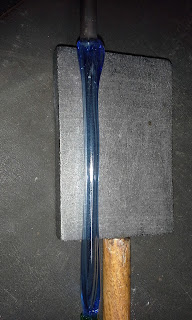After watching a live streaming demonstration from Corning where two glassblowers made drawn glass beads, I wanted to try to make a drawn glass bead myself on a smaller scale using a hollow mandrel I had as a blow pipe, just to see if I could do it. Below are two beads that I made.
The first time I tried do do this, I blew to hard and shattered the bubble. Luckily, I got a feel for how hard to blow the bubble after I messed up the first time. I was able to get a small length of drawn glass, enough to make one or two beads from. This worked as long as I did not pull the walls to thin. If the walls of the bead were too thin, I could not cut the bead using my glass nippers, because the glass would shatter. To properly finish the above beads, I would also need to file the ends ends flat. I'm not quite sure how some of this would be done in period, particularly how the beads were cut and polished in period, but, one book that I've seen before that talks about how drawn beads were made, which I could acquire use as a reference to learn more is Asia's Martime Bead Trade.
Because I'm working with such small amounts of glass, this method would never be efficient to make beads in any number, but, I have seen modern lampworkers make modern ornaments and pendants by blowing glass.
 |
| My first unsuccessful attempt to blow glass. |
 |
| The successful creation of a bubble of blown glass. To create this bubble, I wrapped glass around the end of my hollow mandrel in a way that is a bit similar to making a hollow bead. I then added more glass to the outside before blowing. Lesson Learned: do not coat the hollow mandrel in bead release. The bead release cracked twice and I lost my bubble of glass. |

